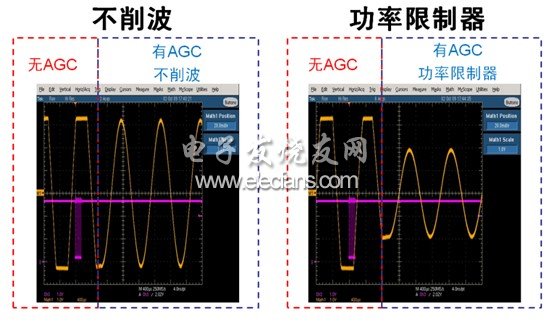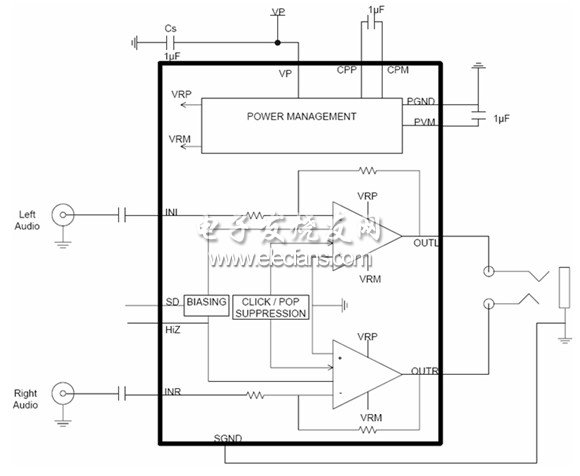In recent years, there have been more and more functions for smartphone integration, but in terms of basic audio amplification applications, there is still room for improvement in continuing to optimize performance and user audio experience. The reason is that there are special audio requirements for smartphones.
This article refers to the address: http://
This article will focus on the performance requirements of smartphone speaker amplifiers and headphone amplifiers, introduces the corresponding audio amplification solutions from ON Semiconductor, and a new audio subsystem solution that integrates stereo headphone amplifiers, Class D speaker amplifiers, and I2C control—audio Management Integrated Circuit (AMIC).

Figure 1: Schematic diagram of audio amplification application for smartphone
Speaker Amplifier Performance Requirements and Solutions
For smartphones, the desired speaker amplifier should provide low electromagnetic interference (EMI) to avoid interference with other radio frequency (RF) circuits in the smartphone. As far as the user's actual application is concerned, the user sometimes wants to make a hands-free voice call in a public place, and sometimes wants to watch the video with audio playback. This requires the speaker amplifier to provide an output level with high recognition while providing low distortion. In addition, low noise is also an important feature provided by the desired speaker amplifier. Specifically, this requires a speaker amplifier with a high power supply rejection ratio (PSRR) to suppress time-division multiple access (TDMA) noise generated by battery voltage fluctuations during GSM signal transmission; it also requires no popping during turn-on and turn-off (pop) And click noise.

Figure 2: Different technologies for reducing EMI
To meet these desired performance requirements for smartphone speaker amplifiers, Class D amplifiers are an excellent choice. Class D amplifiers provide very low EMI and avoid interference with other RF circuits. In fact, the class D amplifier converts the input analog audio signal into a pulse width modulated (PWM) pulse signal, which is then used to control the switching device to turn the audio power amplifier on/off. For smartphone applications, to reduce EMI in the audio output section, it is important to reduce the portion of the spectrum at higher frequencies. Traditional PWM technology has no specific means to deal with it. But to do this, two techniques can be used, one is PWM spread-spectrum modulation (switching frequency change), and the other is PWM with ramp control (delayed rise/fall time). In contrast, ramp control techniques are more efficient than spread spectrum modulation techniques in reducing the frequency of higher frequencies, and are more conducive to reducing EMI.
ON Semiconductor's NCP2824 is a 2.8 W mono Class D amplifier with ramp control technology to provide low EMI. In addition, the NCP2824 provides real-time configuration of automatic gain control (AGC) via a single-wire interface. Its automatic gain control function consists of two modes, nON-clipping and power limiter modes. For speaker amplifiers, clipping occurs when the battery voltage of the smartphone is very low, resulting in reduced output saturation and saturation. The NCP2824's automatic gain control "no clipping" feature maintains low distortion and allows selection of the maximum total harmonic distortion (THD) threshold. On the other hand, excessive output power occurs under high output power conditions, causing the output swing to decrease and saturate. The power limiter function limits the amplifier's output power (the maximum output voltage threshold can be selected) to protect the speaker from damage caused by excessive volume.

Figure 3: NCP2824 supports automatic gain control without clipping and power limiter modes
In addition to low EMI and low distortion, the NCP2824 performs exceptionally well on other key performance indicators of audio amplifiers. For example, this device delivers excellent signal-to-noise ratio (SNR) performance of 95 dB for excellent audio performance. In addition, the NCP2824 also has an excellent power supply rejection ratio (PSSR) with a PSSR of -72 dB at 217 Hz. The NCP2824 also offers up to 92% energy efficiency, helping to extend battery life in portable devices. Operating from 2.5 V to 5.5 V, the device supports a fully differential input (thus eliminating input coupling capacitance) with only one external capacitor. The device also provides short-circuit protection for applications such as smartphones and mobile Internet devices (MIDs), navigation devices, portable game consoles and portable media players.
Headphone amplifier performance requirements and solutions
Smartphone users expect to enjoy high-fidelity (Hi-Fi) quality music playback through headphones, which requires low distortion of the headphone amplifier. Since the earphone is close to the human ear and directly affects the user's hearing experience, the headphone amplifier must have no audible noise. This feature is more important to the headphone amplifier than to the speaker amplifier. In addition, headphone amplifiers are also required to be energy efficient, helping to extend music playback time.
In order to meet consumers' higher requirements for headphone audio quality, portable consumer devices such as smart phones require high quality stereo headphone amplifiers. When designing the output stage of a stereo headphone amplifier, designers need to choose a more suitable solution from different options such as capacitive coupling and true ground. The capacitive coupling scheme is energy efficient because the power supply is only powered by the positive output signal; however, this solution uses large coupling capacitors (which can breed size and cost) and has poor sound quality at low frequencies. In comparison, the real grounding scheme does not require the use of coupling capacitors, has good low-frequency response, and the headphones are grounded in conjunction with conventional converters, but the true grounding structure is not energy efficient. Overall, the true grounding scheme provides lower distortion and smaller solution size, with an emphasis on improving energy efficiency and helping to extend audio playback time. For headphone amplifiers, static power (ie, quiescent current) is a major component of their overall power consumption in order to provide a comfortable level of hearing. Therefore, minimizing quiescent current is critical to improving the energy efficiency of the headphone amplifier. The NCP2815 is an ultra-low quiescent current (Iq) stereo headphone amplifier from ON Semiconductor that delivers ultra-low quiescent current of 1.8 mA to help extend audio playback time.
The device also offers a high-impedance (High Z) output mode that supports audio input/output for the audio jack. The NCP2815 supports common mode sensing and eliminates ground loop noise. The device supports a wide supply voltage of 1.6 V to 3.6 V, consumes 1.8 V, consumes only 20 mW at 16 Ω, and has less than 0.01% total harmonic distortion plus noise (THD + N). The NCP2815 offers a high power supply rejection ratio of -100 dB, a fixed internal gain (-1.5 V/V) or an externally adjustable gain, as well as pop and click noise cancellation circuitry. The 1.2 mm x 1.6 mm CSP package makes the NCP2815 the smallest part of its class on the market.

Figure 4: Block Diagram of the NCP2815 "Long Play Time" Stereo Headphone Amplifier
Audio Subsystem Solution - Highly Integrated Audio Management IC
As the premier supplier of high-performance silicon solutions for energy-efficient electronics, ON Semiconductor not only introduces these stand-alone high-performance speaker amplifiers and stereo headphone amplifiers, but also introduces audio amplifiers that integrate stereo headphone amplifiers, speaker amplifiers and I2C control. System Solution - Audio Management Integrated Circuit (AMIC) provides flexible cabling and muxing between the two audio input sources of the speaker and headphone output, such as the NCP2704 and NCP2705.

Figure 5: Functional diagram of the audio management integrated circuit
Among them, NCP2704 is a PWM Class D audio management integrated device with ramp control to help reduce EMI. This device provides fully programmable automatic gain control to ensure excellent audio output quality and speaker protection. The NCP2704's integrated headphone amplifier features ultra-low quiescent current consumption to help extend audio playback time. The device also offers extensive input/output multiplex control to increase device flexibility. The NCP2704's integrated headphone amplifier has a THD+N value of only 0.02% and a speaker amplifier of 0.042%; the corresponding headphone amplifier has a power supply rejection ratio of -100 dB and a speaker amplifier of -89 dB. The NCP2704 offers a wide and accurate gain selection (mute and -60 dB to +12 dB).
The NCP2705 is also a Class D audio management IC with similar features to the NCP2704, but the NCP2705 adds common mode sensing. This feature improves crosstalk performance, especially in the case of FM tuners with parasitic resistance. The NCP2705 has a lower THD+N value, 0.01% for the headphone amplifier and 0.017% for the speaker amplifier.

Figure 6: Block diagram of Class D audio management IC with common mode sensing function NCP2705
to sum up
Designers use the NCP2824, a Class D speaker amplifier with ramp control from ON Semiconductor, to effectively reduce high-frequency EMI interference to RF circuits while ensuring that the speakers play audio with the “No Clipping†Automatic Gain Control (AGC) feature. Provides low distortion and protects the speaker from damage with the “Power Limiter†AGC function. At the same time, designers use the ultra-low quiescent current stereo headphone amplifier NCP2815 from ON Semiconductor to extend the audio playback time of smartphones.
Aluminum Electrolytic Capacitors
Aluminum Electrolytic Capacitor,1Uf Capacitor,2.2Uf Capacitors,4.7Uf Capacitors
JINGGANGSHAN MEICHENG ELECTRONIC TRADING CO.,LTD , https://www.meicheng-tra.com